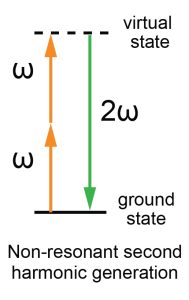At Oryl Photonics, we developed a technology based on Second Harmonic Scattering (SHS). This is the combination of second harmonic generation and light scattering.
Second harmonic generation is an optical process where light at a fixed frequency illuminates and excites a material following specific rules. The light and the matter interact, and the material will re-emit the light at twice the frequency of the original (incident) light. This light at twice the frequency is called second harmonic light. This means for instance that when the incident light has a wavelength of 1030 nm (near-infrared), the emitted second harmonic light will have a wavelength of 515 nm (green).

Energy diagram of non-resonant second harmonic generation: Two incident photons at frequency ω excite the material to a virtual state. The material then emits a new photon at frequency 2ω – the second harmonic – and relaxes to its original ground state.
As this optical process changes the wavelength of the light during the interaction (2 photons combine into one), it is called a non-linear process. On the opposite, the process where the wavelength would remain the same (one photon converts into one photon) is defined as linear.
This non-linear process occurs when specific conditions are met within the material. In general, when there are centrosymmetries (symmetries around a point), there are destructive interferences, and second harmonic is not generated.
- The first condition is the presence of anisotropy in the electronic clouds of the molecules of the material: a part of the molecule is charged more positively or negatively than the rest, thus creating a dipole. A dipolar molecule allows the generation of second harmonic at the molecular level. This works well with water for instance.
- The second condition is that the dipolar molecules must be arranged in a non-centrosymmetric (or anisotropic) way to allow generation of second harmonic at the material level.
Only when both of these conditions are met, second harmonic is generated by the material under illumination. For example, there is no second harmonic generated in the following cases:

On the opposite, second harmonic generation is allowed in these cases:

Because of this peculiar symmetry dependance, studying the second harmonic light emitted by a material provides a wealth of information on how its molecules are structured.
There are several ways to implement it. The first one is to shine your laser light on a planar sample and look at the second harmonic light that is reflected by the surface. the problem is that such surface studies are very sensitive to impurities, thus the samples are challenging to prepare. Also, these interfaces do not represent well the real interfaces in nature, where real flatness is scarce.
The solution is to combine second harmonic generation with a scattering geometry. When shining the laser through the sample, second harmonic light will be generated in different directions. By collecting this scattering, you can probe the bulk of the material and you are not restrained to flat surfaces. The preparation of samples is less tedious and you can study more complex and realistic systems similar to what you find in nature. Second harmonic scattering is especially suitable to probe bulk media such as liquids, or particles, vesicles and droplets in suspension where there is no planar interface. It is used to study liposomes, emulsions, or even pure liquids.
One key application is the measurement of solubility: when a drug compound is not dissolved properly in a liquid, undissolved particles float in the liquid. This is an interface between the particle and the liquid molecules around it. The molecules reorient and redistribute to accommodate the presence of the particle, on a large volume. Second harmonic scattering can then probe the rearrangement of the liquid, the solvent, in a very sensitive way. This is what we call the Solvent Redistribution method.

